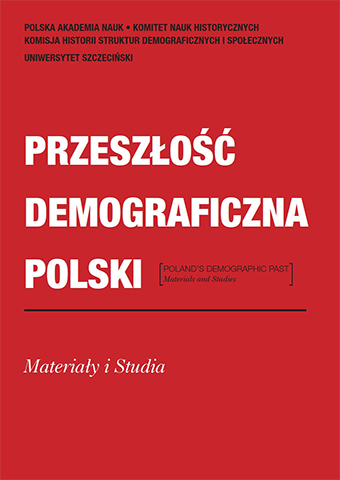







| Autoren: |
Bartosz
Ogórek
Uniwersytet Pedagogiczny im. Komisji Edukacji Narodowej w Krakowie, Wydział Humanistyczny |
| Schlüsselbegriffe: | krytyka źródeł model biometryczny umieralność niemowląt |
| Data publikacji całości: | 2016 |
| Seitenanzahl: | 12 (135-146) |
| 1. | Bourgeois-Pichat, Jean. „Analyse de la mortalité infantile”. Revue de l’Institut International de Statistique 18 (1950): 45–68. |
| 2. | Bourgeois-Pichat, Jean. „La mesure de la mortalité infantile. I: Principes et méthodes”, Population 6 (1951), 2: 233–248. |
| 3. | Bourgeois-Pichat, Jean. „La mesure de la mortalité infantile. II: Les causes de décès”, Population 6 (1951), 3: 459–480. |
| 4. | Huck, Paul. „Infant Mortality and Living Standards of English Workers during the Industrial Revolution”. The Journal of Economic History 55 (1995), 3: 528–550. |
| 5. | Knodel, John, Hallie Kintner. „The Impact of Breast Feeding Patterns on the Biometric Analysis of Infant Mortality”. Demography 14 (1977), 4: 391–409. |
| 6. | Kuklo, Cezary. „O potrzebie intensyfikacji badań nad strukturami demograficznymi rodzin na ziemiach polskich do początku XX wieku”, Przeszłość Demograficzna Polski 37 (2015): 7–36. |
| 7. | Lévy, Michel L. „In Memoriam”. Population et Societes. Bulletin Mensuel d’Information Demographiques, Economiques, Sociales 246 (1990): 1. |
| 8. | Lynch, Katherine A., Joel B. Greenhouse, Anders Brändström. „Biometric Modeling in the Study of Infant Mortality: Evidence from Nineteenth-Century Sweden”. Historical Methods: A Journal of Quantitative and Interdisciplinary History 31 (1998), 2: 53–64. |
| 9. | Manfredini, Matteo. „The Bourgeois‐Pichat’s Biometric Method and the Influence of Climate: New Evidences from Late 19th‐century Italy”. Social Biology 51 (2004), 1–2: 24–36. |
| 10. | Nadot, Robert. „Évolution de la mortalité infantile endogène en France dans la deuxième moitié du XIXe siècle”. Population 25 (1970), 1: 49–58. |
| 11. | Ogórek, Bartosz. „Populacja Krakowa w kontekście długofalowych procesów demograficznych na przełomie XIX i XX wieku”. Przeszłość Demograficzna Polski 32 (2013): 25–87. |
| 12. | Piasecki, Edmund. Ludność parafii bejskiej (woj. kieleckie) w świetle ksiąg metrykalnych z XVIII–XX w. Studium demograficzne. Warszawa–Wrocław: PWN, 1990. |
| 13. | Scott, Susan, Christopher J.Duncan. „Malnutrition, Pregnancy, and Infant Mortality: A Biometric Model”. The Journal of Interdisciplinary History 30 (1990), 1: 37–60. |
| 14. | Sperk, Bernhard. „Referat zur Statistik über die Häufigkeit des Stillens”. Das Österreichische Sanitätswesen 18 (1906). Beilagen: Studien und Vorschläge zur Förderung des Selbststillens in Österreich. Referate und ein Mahnwort an die Ärzte: 43–47. |
| 15. | Vallin, Jacques, Giovanni Berlinguer. „From Endogenous Mortality to the Maximum Human Life Span”. W: Demography: Analysis and Synthesis, t. 2, red. Graziella Caselli, Jacques Vallin, Guillaume Wunsch, 95–115. Amsterdam–Tokyo: Elsevier, 2006. |
| 16. | Wrigley, Edward A. „Births and Baptisms: The Use of Anglican Baptism Registers as a Source of Information about the Numbers of Births in England before the Beginning of Civil Registration”. Population Studies 31 (1977), 2: 281–312. |